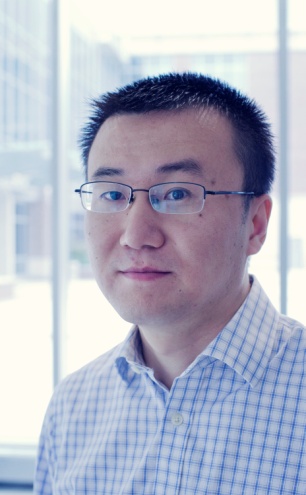“求是材料科学论坛”(第五十一讲)
斯坦福大学教授学术报告会
【报告时间】2016年10月31日下午3:00
【报告地点】邵科楼报告厅211
【报告题目】1.Viscoelasticity in (Nearly) Two Dimensions; 2. Industry-University Research Relationships at Stanford
【主讲人】Prof.Gerald Fuller 院士
【报告题目】Materials Science Approaches Developmental Biology
【主讲人】Prof.Bo Wang
【邀请人】韩高荣 教授
【报告摘要】
Viscoelasticity in (Nearly) Two Dimensions (by Prof.Fuller)
The interfaces separating bulk fluids, whether they occur in nature or encountered in technological applications, are very often populated by surface active species can render them viscoelastic. Prominent examples include the tear film of the eye where complex phospholipid mixtures (the meibum) stabilize this thin film against dewetting, monoclonal antibody solutions where absorptive layers are the precursors to unwanted aggregation phenomena, and asphaltenes that inhibit coalescence within water-in-oil emulsions. This lecture will explore these applications and demonstrate the connection of interfacial viscoelasticity to the underlying physics.
Applications where interfacial rheology is important most often involve thin liquid films where fluid mechanical boundary conditions are modified to account for the ability to support shear and dilatational stresses. Consequently, studies of such processes must combine experimental methods with the capability of following the dynamics of thin films undergoing flow with the development of new interfacial rheometers. This presentation will introduce two new instruments, the interfacial drainage and dewetting optical platform (i-DDrOP) and the dynamic fluid film interferometer (DFFI) to accomplish the former requirement. Interfacial rheological characterization is accomplished by several techniques developed in the Fuller laboratory: the interfacial stress rheometer, the double wall ring, and the dilating drop.
Materials Science Approaches Developmental Biology (by Prof.Wang)
Although materials science approaches have hugely impacted many medical areas, including tissue engineering, drug delivery, gene therapy, and biomechanics, they have been rarely engaged to access basic biology. However, many major bottlenecks in biology present technical challenges for which materials science seems to provide perfect solutions. In this talk, I will present two examples from my lab. First, we have used basic ideas in polymer physic, including hydrogel and interpenetrating networks to achieve super-resolution fluorescence imaging in whole animals. Second, we have used cell-membrane coated polymer nanoparticles to molecularly dissect and manipulate parasite-human interactions. With these tools, our work aims to cut across the traditional boundaries between materials science and developmental biology to bring functional genomic analyses of animal development to scales that are previously inaccessible.
【报告人简介】
 Gerald Fuller is the Fletcher Jones Professor of Chemical Engineering at Stanford University. He joined Stanford in 1980 following his graduate work at Caltech where he acquire his MS and PhD degrees. His undergraduate education was obtained at the University of Calgary, Canada. Professor Fuller's interests lie in studies of rheology and interfacial fluid mechanics. His work has been recognized by receipt of the Bingham Medal of The Society of Rheology, membership in the National Academy of Engineering, election to the American Academy of Arts and Science, and honorary doctorates from the Universities of Crete, Greece, and Leuven, Belgium.
Gerald Fuller is the Fletcher Jones Professor of Chemical Engineering at Stanford University. He joined Stanford in 1980 following his graduate work at Caltech where he acquire his MS and PhD degrees. His undergraduate education was obtained at the University of Calgary, Canada. Professor Fuller's interests lie in studies of rheology and interfacial fluid mechanics. His work has been recognized by receipt of the Bingham Medal of The Society of Rheology, membership in the National Academy of Engineering, election to the American Academy of Arts and Science, and honorary doctorates from the Universities of Crete, Greece, and Leuven, Belgium.
 Bo Wang attended the Zhejiang University 2000-2004, as an undergraduate of the inaugural class of the Chu Kochen Honors College. He continued on at ZJU and obtained his M.S. in materials science with Changyou Gao at 2006. After that, he went to the University of Illinois at Urbana-Champaign to work with Steve Granick, and received his Ph.D. in 2011. He transitioned to biology as a postdoctoral fellow at the Howard Hughes Medical Institute working with Phillip Newmark. He joined Stanford as an assistant professor of Bioengineering and Developmental Biology in 2015. Bo's research uses the freshwater flatworm planarian and its evolutionary cousins, the human parasitic flatworms, as models to answer a broad set of questions in evolution, development, infection and immunity. His lab is also committed to develop micro and nano scale tools to better access and manipulate biology. Bo is a recipient of the Career Award at the Scientific Interface (CASI) from the Burroughs Wellcome Fund. His awards also include the Victor K. LaMer Award from the American Chemical Society, and the Frank J. Padden, Jr. Award from the American Physical Society.
Bo Wang attended the Zhejiang University 2000-2004, as an undergraduate of the inaugural class of the Chu Kochen Honors College. He continued on at ZJU and obtained his M.S. in materials science with Changyou Gao at 2006. After that, he went to the University of Illinois at Urbana-Champaign to work with Steve Granick, and received his Ph.D. in 2011. He transitioned to biology as a postdoctoral fellow at the Howard Hughes Medical Institute working with Phillip Newmark. He joined Stanford as an assistant professor of Bioengineering and Developmental Biology in 2015. Bo's research uses the freshwater flatworm planarian and its evolutionary cousins, the human parasitic flatworms, as models to answer a broad set of questions in evolution, development, infection and immunity. His lab is also committed to develop micro and nano scale tools to better access and manipulate biology. Bo is a recipient of the Career Award at the Scientific Interface (CASI) from the Burroughs Wellcome Fund. His awards also include the Victor K. LaMer Award from the American Chemical Society, and the Frank J. Padden, Jr. Award from the American Physical Society.
主办:浙江大学材料科学与工程学院
宣传:浙江大学材料学院研博会

